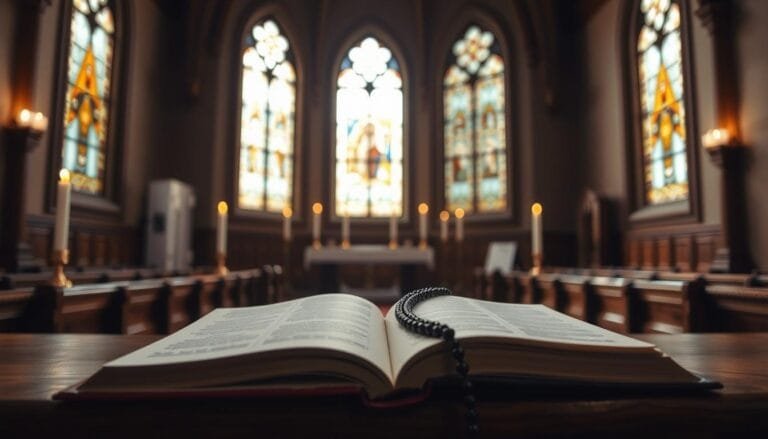Embracing Spontaneous Prayer
This website contains affiliate links. As an Amazon Associate, I earn from qualifying purchases. The content on this website was created with the help of AI.
Spontaneous prayer is more than just a quick thought. It’s a real conversation with God that happens every day.
For Catholics, it means talking to God in moments of happiness, trouble, or quiet thought. It can be as simple as saying “Help” when you’re stressed or thanking God for a meal.
These short talks show our faith in action. The Catechism teaches us that prayer is about building a relationship, not just following rules.
Spontaneous prayer lets us speak to God like a close friend.
Consider the tax collector’s prayer in Luke 18:13. He says, “Have mercy on me, Lord, for I am a sinner.”
This shows how a few sincere words can bring us closer to God.
Today, Catholics can pray “Lord, make good come out of this suffering” when facing challenges or say “Offer It Up” to connect their struggles with Christ’s sacrifice.
These actions show that spontaneous prayer does not replace the Hail Mary or Mass. It’s a way to deepen our faith journey.
Key Takeaways
- Spontaneous prayer strengthens intimacy with Christ through everyday talking to God.
- Traditional prayers like the Hail Mary and modern phrases like “I give up, Lord. You take care of it” coexist in Catholic spirituality.
- Jesus taught that prayer should be sincere, not formulaic (Matthew 6:5- 6), urging private conversations with God.
- Short prayers like “Help!” or structured phrases can turn routine tasks into sacred moments of Catholic prayer.
- Spontaneous prayer practices align with saints’ examples, making faith alive in daily life.
Understanding Spontaneous Prayer in the Catholic Tradition
Spontaneous prayer is not against Catholic tradition but is a part of it. Our faith encourages both formal and free prayers.
This mix helps us connect with God through spiritual conversation and set prayers.
The Biblical Foundations of Praying from the Heart
In Gethsemane, Jesus showed us how to pray from the heart. He said, “Abba, Father, all things are possible to you” (Mark 14:36).
“Pray without ceasing,” Paul tells us (1 Thessalonians 5:17). These words show biblical prayer can be both written and spoken freely. David’s psalms, for example, mix emotions into praise and sorrow.
How Spontaneous Prayer Complements Formal Practices
Spontaneous prayer adds to, not takes away from, prayer forms like the Rosary or Mass. Here’s how they complement each other:
- Formal prayers teach us sacred truths
- Spontaneous prayers share our personal needs
- Together, they strengthen our bond with God
Many Catholics might feel shy about improvising (50% prefer structured prayers for this reason). Yet, even saints like Augustine started with set prayers to grow closer to God.
Distinguishing Between Different Prayer Forms
Our faith offers many ways to pray:
- Liturgical: Set prayers in Mass
- Devotional: Familiar prayers like the Hail Mary
- Contemplative: Silent awareness of God’s presence
- Spontaneous: Unscripted words from the heart
All these forms are okay. The aim is to let God’s Spirit lead your heart while respecting tradition.
The Spiritual Benefits of Speaking Freely with God
Prayer becomes more meaningful when we speak to God like a friend. This approach deepens our bond with God, a key part of Catholic spirituality.
Praying freely opens our hearts to the Holy Spirit, leading to spiritual growth through genuine conversations.
- Intimacy with Christ: Unscripted prayer makes our relationship with God more real and trusting.
- Emotional honesty: Sharing our feelings, whether happy, sad, or confused, is like Paul’s “groaning” in Romans 8:26.
- Clarity in faith: Spontaneous prayer, as St. Teresa of Ávila showed, helps us hear God’s voice in everyday life, following Catholic teachings.
“Prayer is not about perfect words—it’s about presence,” says one spiritual director. “God listens to the heart, not just the tongue.”
Many Catholics find that praying freely adds to traditional prayers like the Rosary. Mixing structured prayers with spontaneous talks honors both tradition and personal faith.
Consider how a Catholic spiritual director can help find this balance for guidance.
Catholic spirituality values both ritual and genuine connection. Let your heart speak freely, knowing God is always there to meet you.
This exchange shows how prayer can turn everyday moments into sacred times with the divine.
How the Saints Practiced Spontaneous Prayer
Catholic saints showed us how to pray without scripts. St. Teresa of Avila saw prayer as a “conversation between friends.”
She mixed heartfelt talks with traditional prayers. Her writings reveal a balance between structured and free prayer.

St. Francis of Assisi prayed in nature, creating hymns to express his worship. He found God in fields and forests.
“The Hail Mary… has not only been a foundational contemplative prayer but also one of galvanizing grace in times of trouble.”
Modern saints like St. Thérèse of Lisieux found God in everyday tasks. St. Faustina wrote down raw conversations with Christ. St. Padre Pio taught us to pray briefly in tough times.
These stories show that spontaneous prayer can deepen our faith, alongside sacraments.
- St. Teresa: Mixed informal prayer with the Divine Office
- St. Francis: Created nature-inspired prayers
- Modern Saints: Used simple, situational dialogue
We can trust that God listens to our raw words like the saints. Their lives teach us that spontaneity can deepen our connection with God.
Let their examples inspire your own path to genuine, joyful prayer.
Developing Your Personal Spontaneous Prayer Practice
Starting a strong prayer practice is all about taking small steps. Let’s look at three ways to incorporate spontaneous prayer into your Catholic prayer life.
Creating Sacred Space in Daily Life
Start by setting aside time and space for God. Find a quiet spot, maybe near a crucifix or family shrine.
Scripture says, “When you pray, go to your room, close the door, and pray to your Father in private” (Matthew 6:6).
Make your sacred space simple, like a morning coffee ritual or a quick pause before meals. Here are some ideas:
- Place a rosary or scapular as visual reminders
- Light a candle during daily tasks
- Use a pocket-sized prayer card for spontaneous intercessions
Overcoming Common Prayer Obstacles
Many worry about saying the wrong thing: “What if I say the wrong thing?” But God wants your heart, not perfection. Here are some tips:
| Obstacle | Practical Solution |
|---|---|
| Feeling “un-Catholic” | Start with Scripture phrases like “Thy will be done” |
| Worrying about mistakes | Use the Berakhah formula: 1. Praise God 2. Remember His faithfulness 3. Present petitions |
| Lack of time | Begin with 2-minute pauses at routine moments |

Balancing Structure and Freedom
Mix tradition with creativity. Start with the Our Father, then talk to God freely. End the day by reflecting on your actions. This balance keeps your prayer practice strong and heartfelt.
Fr. Robert Spitzer’s prayers are simple, like “Help” or “Lord, make good come out of this suffering.”
Even short prayers, like “Bless this moment,” can connect you to God all day. Let sacred space and practical steps help deepen your Catholic prayer life.
Spontaneous Prayer in Catholic Family Life
Imagine your child looking up at the sky and saying, “Let’s ask God to calm the rain.” That’s family prayer in action—a moment of trust and faith.
In a Catholic home, spontaneous prayer creates the domestic church. Here, everyday moments become sacred talks with God.
Start by showing your kids what Catholic parenting looks like. When you stop at a red light, pray for the driver behind you: “God, bless this family’s journey today.”
These small acts teach children to pray as naturally as breathing. The Catechism says, “Prayer is the heart’s sincere expression” (CCC 2558), making even simple words holy.
- At bedtime: Let each family member name one worry to hand to God.
- Mealtime graces: Add a spontaneous request for someone outside your home.
- Car rides: Turn traffic frustrations into prayers for drivers and pedestrians.
When doubts arise, remember the WWII veteran who found peace with the Hail Mary in gunfire. Your family can turn chaos into communion. Check out this guide for simple phrases for kids.
Spontaneous prayer isn’t about being perfect—it’s about being present. As a priest once said, “God listens even when our words stumble.”
Let your home be filled with prayers that reflect life’s rhythms, building a legacy of faith through shared whispers to heaven.
The Transformative Power of Unscripted Conversations with God
Praying without scripts opens our hearts to prayer transformation. It heals both soul and spirit.
Scripture tells us to “pray without ceasing” (1 Thessalonians 5:18). It invites us to trust God with our deepest feelings.
“The first and most important prayer here is ‘Help,’”
This truth is seen in the lives of saints. They turned to God with simplicity. Their unfiltered talks with God lead to spiritual healing. Pain becomes a path to divine mercy.
Healing Through Authentic Expression in Prayer
God meets us in our vulnerability. Whether through tears or joy, honest prayers break down barriers. Catholics can pray freely, trusting that even broken words can be channels of grace.
Like Teresa of Ávila, the saints taught us to speak to God as a friend. When we pray “Help!” in times of crisis, we join the Holy Spirit’s work. This turns suffering into spiritual healing.
Building Intimacy with Christ Through Regular Dialogue
Intimacy with Christ grows through daily conversations in prayer. Imagine the Eucharist as a meal with a friend. Spontaneous prayers deepen this closeness.
Regular talks with God, like John 15:15, make us friends with Jesus. Even brief moments of prayer during daily activities strengthen our faith and make it feel alive.
When God Responds: Recognizing Answers to Spontaneous Prayers
God answers in ways that grow our faith. Answered prayers can be peace, a timely word from Scripture, or a shared meal.
Discern answers through:
- Scripture reflections
- Guidance from spiritual directors
- Shifts in heart attitudes
Trust the Holy Spirit’s whispers. God’s responses often come as a “still, small voice” (1 Kings 19:12).
Conclusion: Integrating Spontaneous Prayer into Your Catholic Faith Journey
Reflecting on your Catholic faith journey, remember that prayer integration is key. Saints showed us how to balance structured and spontaneous prayer.
They proved that closeness to God comes from both tradition and authenticity.
Start small by adding one unplanned prayer moment each day. It could be during morning coffee or while walking. This simple step can make a big difference.
Begin with daily devotions like the Morning Offering. Then, let your heart guide you. The Lay Cistercians of South Florida show how to blend prayer with daily activities.
Emmanuel Catholic Church holds monthly prayer walks, which combine movement with spontaneous prayer. Such practices make prayer a natural part of life.
Being consistent in prayer commitment turns everyday moments into sacred ones. Whether it’s a quick “Thank You” or a 2-minute reflection, these acts honor God’s presence.
Just like the early Church, your prayer rule can evolve while staying true to your faith.
Embrace this balance. Your Catholic faith journey becomes a living conversation with God. Let spontaneous prayer be as natural as breathing.
Trust in tradition and the Holy Spirit’s guidance to find your path to holiness.








